Rachel is wearing TruHearing 6 Slim RIC hearing aid.
Your TruHearing® benefit makes it easier, more convenient, and more affordable than ever to treat your hearing loss. Modern hearing aids are smaller, sleeker, and smarter than you’d expect—like powerful mini-computers for your ears.
Discover the best hearing aids at the best pricing.
1-800-334-1807
Rachel is wearing TruHearing 6 Slim RIC hearing aid.
(Re)®Discover your world through better hearing.
Your TruHearing benefit makes it easier, more convenient, and more affordable than ever to treat your hearing loss. Modern hearing aids are smaller, sleeker, and smarter than you’d expect—like powerful mini-computers for your ears.
Find out more about what today’s hearing aids offer.
1-800-334-1807
Options for every need
Your provider will work with you to choose the perfect hearing aids for your budget, lifestyle, degree of hearing loss, and technology needs.
RIC
IIC
ITE
ITC
CIC
BTE

Receiver-in-Canal (RIC)
RIC devices sit behind the ear with a micro-tube that sends signals to a receiver inside the ear canal. They offer highly advanced connectivity and audio processing technology.
RICs are appropriate for all but the most profound hearing loss. They are small, discreet, and versatile, making them the most popular hearing aid style.
Hearing Loss: Appropriate for mild, moderate, or severe hearing loss
Visibility: Relatively discreet
Popularity:
![]()
The latest styles
Today’s hearing aids come in a wide variety of styles, so you can find a solution as unique as you are. From traditional behind-the-ear devices to practically invisible models, modern hearing devices are smaller than ever before with advanced sound processing capabilities.
Learn more about TruHearing brand hearing aids
Receiver-in-Canal (RIC)
RIC devices sit behind the ear with a micro-tube that sends signals to a receiver inside the ear canal. They offer highly advanced connectivity and audio processing technology.
RICs are appropriate for all but the most profound hearing loss. They are small, discreet, and versatile, making them the most popular hearing aid style.
Hearing Loss: Appropriate for mild, moderate, or severe hearing loss
Visibility: Relatively discreet
Popularity:

Invisible-in-the-Canal (IIC)
The IIC is the smallest and most discreet hearing aid available today. It rests deep in the ear canal for a nearly invisible look.
IICs are appropriate for mild to moderate hearing loss. They require a larger ear canal and may need more maintenance than other styles. IICs work best in quieter settings with minimal background noise.
Hearing Loss: Appropriate for mild to moderate hearing loss
Visibility: Nearly invisible
Popularity:
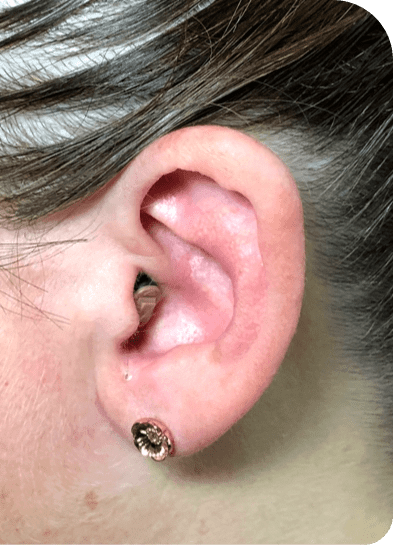
In-the-Ear (ITE)
ITEs are custom-made to fit entirely inside the ear. They come in a wide variety of colors and offer many advanced features. ITEs are typically large enough to include manual controls.
ITEs are suitable for mild to severe hearing loss. People with dexterity issues may find them easier to adjust than other styles. They may pick up background noise, so they work best in quieter settings.
Hearing Loss: Appropriate for mild, moderate, or severe hearing loss
Visibility: Relatively discreet
Popularity:

In-the-Canal (ITC)
ITCs are custom-molded to fit directly into the ear canal. They are smaller and more discreet than ITE models, with even more options and advanced features.
ITCs are appropriate for mild to moderately-severe hearing loss. Their smaller size may be difficult to manage for people with dexterity issues. ITCs are best for less-active lifestyles and small group settings.
Hearing Loss: Appropriate for mild to moderate hearing loss
Visibility: Relatively discreet
Popularity:
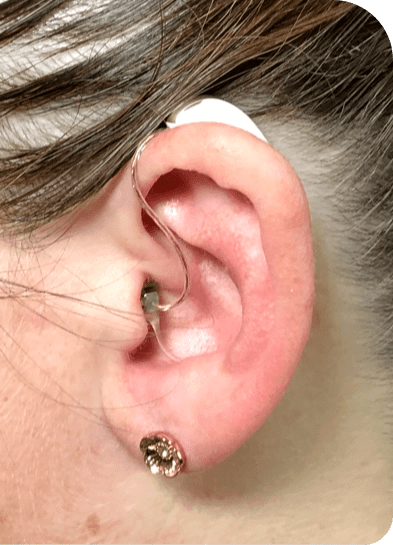
Completely-in-the-Canal (CIC)
The smallest of custom-molded hearing aid styles, CICs fit deep in the ear canal to offer a comfortable fit and nearly invisible look, with robust options to customize sound.
CICs are suitable for mild to moderate hearing loss. They may be challenging for those with dexterity issues and require a larger ear canal. They can be adjusted to handle even the most challenging hearing environments.
Hearing Loss: Appropriate for mild to moderate hearing loss
Visibility: Nearly invisible
Popularity:
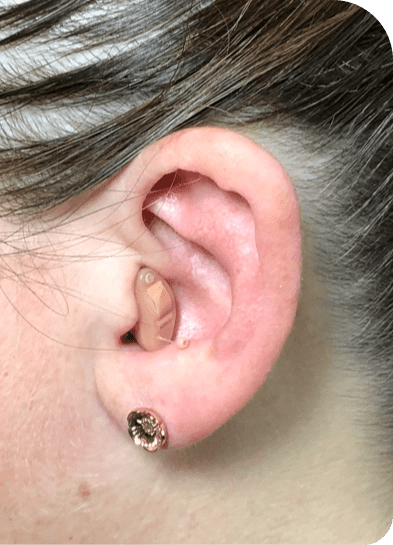
Behind-the-Ear (BTE)
BTEs sit outside the ear, connected to a custom earpiece within the ear. They are the most powerful style of hearing aid and come in a variety of sizes.
BTE devices are suitable for any level of hearing loss. They tend to be durable and perform well in noisy environments, making them a good choice for an active lifestyle.
Hearing Loss: Appropriate for any level of hearing loss, from mild to profound
Visibility: Less discreet
Popularity:
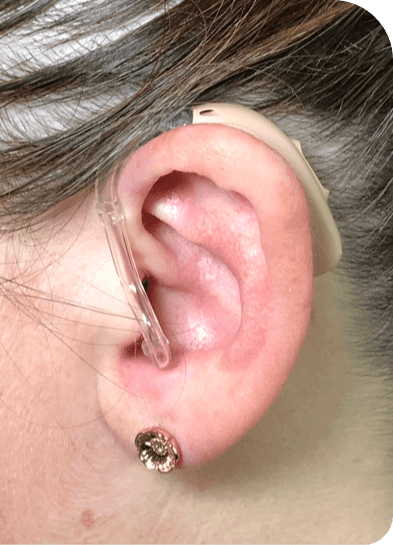
Your journey to hearing health starts with one call.
Don’t wait any longer! Our Hearing Consultants can help you get started.
1-800-334-1807

The leading brands
In addition to our own industry-leading hearing aids, TruHearing works with the world’s top manufacturers* to give you a vast range of high-quality choices—regardless of your budget or level of hearing loss.
We’re committed to your needs, so you can rest assured that every hearing aid we offer is built to fit more comfortably, perform better, and last longer than ever before.
*Hearing aid options vary based on coverage.
Learn more about our manufacturers
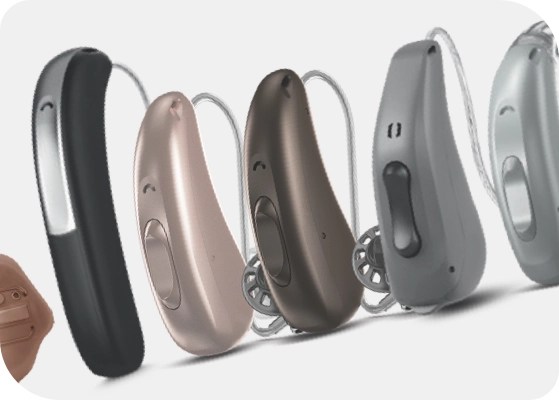
![]()
Don’t worry—we’ve got
you covered.
Every hearing aid purchased through TruHearing comes with a 60-day no-risk trial period, plus a comprehensive 3-year manufacturer warranty.
Hearing aid technology
level comparison
Hearing aid devices typically fall into one of four levels of digital technology: Basic, Standard, Advanced, and Premium. Chips, components, features, and connectivity determine a device’s technology level.
Basic
Up to 8 channels
Limited styles available
Natural sound level
Basic hearing aids are for people with mild to moderate hearing loss and a quiet, less active lifestyle.
Key features:
• Limited noise reduction
• Basic feedback cancellation
Standard
Up to 16 channels
Many styles available
Natural sound level
Standard hearing aids work well
for people who spend most of
their time in predictable environments.
Key features:
- • Manual digital processing
- • Adjustable speech enhancement
- • Adjustable feedback cancellation
- • Noise reduction
- • Wireless connectivity
Advanced
Up to 32 channels
Most styles available
Natural sound level
Advanced hearing aids work for those with an active lifestyle and those who spend time in challenging environments.
Key features:
- • Automated digital processing
- • Adjustable speech enhancement
- • Adjustable feedback cancellation
- • Noise reduction
- • Wireless connectivity
- • Artificial Intelligence technology
- • Rechargeability
Premium
Up to 48 channels
All styles available
Natural sound level
Premium hearing aids support you in the most challenging environments, like restaurants or large groups of people.
Key features:
- • Premium automated digital
processing - • Adjustable speech enhancement
- • Adjustable feedback cancellation
- • Adaptive directional microphones
- • Wind noise management
- • Automatic noise reduction
- • Wireless connectivity
- • Artificial Intelligence technology
- • Rechargeability
- • Extended bandwidth for better perception of speech and sound
A partner on your hearing journey.
New hearing aids sometimes require adjustment to provide the hearing experience you need. Your TruHearing benefit includes one year of follow-up visits with your hearing health provider to get the settings just right.
We’ll also be there to help as you get used to wearing and caring for your new hearing aids. Ongoing educational information will be sent directly to you, and you can always refer to our library of educational materials for tips and advice.
View resources


120 Batteries. Only $39.
Great batteries.
Low prices.
Free delivery.
1-800-334-1807
